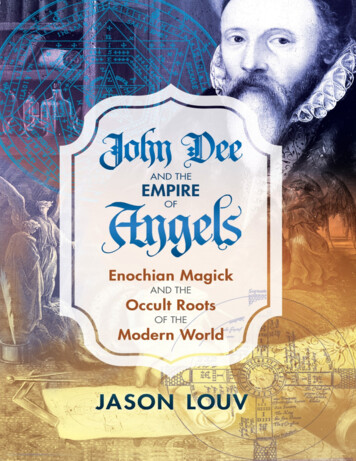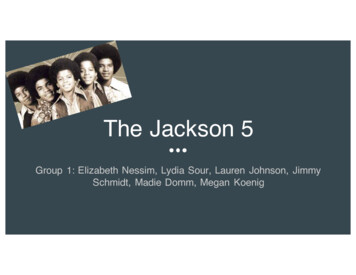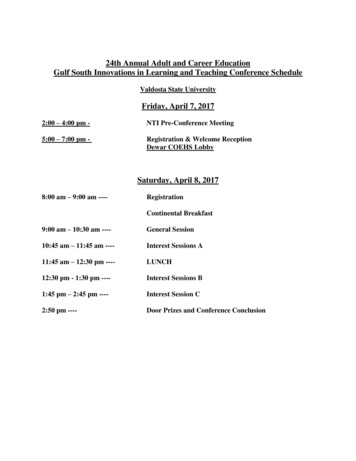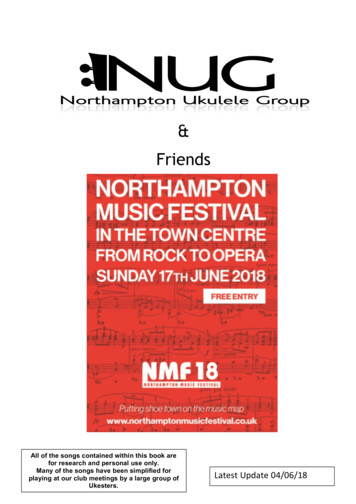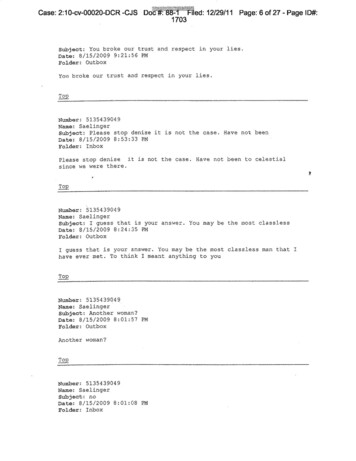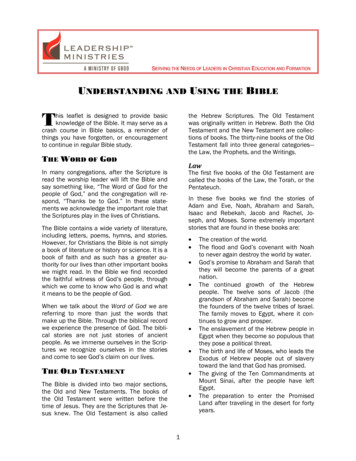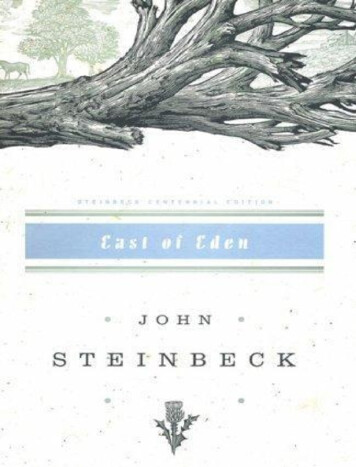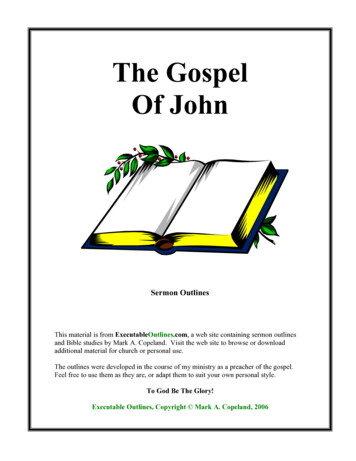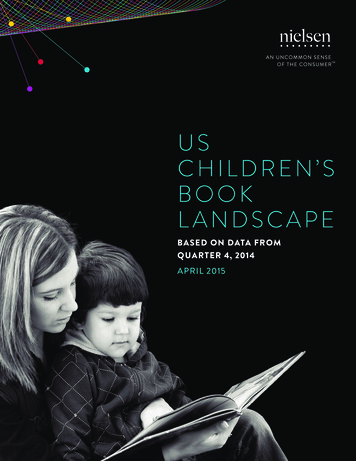
Transcription
Table of ContentsTitle PageCopyright PageDedicationPREFACE TO THE REVISED EDITIONABBREVIATIONSIntroductionPREFACEMysteriorum Liber PrimusAnno 1581 Decembris 22. Mane MortlakAnno 1582. Martij die. 10. hora 11¼ Ante meridiem. SaterdayThe same Saterday after none. Hora. 5.1582 Martij 11 - Sonday. a Meridie hora .3. a circiter.Martij 14. Wensday. mane circa horam 9ã.Martij 15. Thursday. Hora 1¼ a meridie.[Mysteriorum Liber Secundus]Tuesday the 20 of Marche: circa 10ã mane.A meridie circa 2ãWensday 21 Martij, circa 2ã a meridie.Mysteriorum, liber Tertius.Anno 1582 Aprilis 28 a meridie hora 4.Aprilis 29: Sonday: Nocte hora 8¼.Fryday Maij 4: hor 2½ a meridieQuartus Liber Mysteriorum1582 Die A meridie: hora 5. Nouemb. 16.Friday. After drinking at night, circiter horam 8 ã.Anno 1582: Saterday. Die 17. Nouemb: A meridie hora circiter 1 ã.After 7 of the clok at night. die .Monday. Nouembris 19: Circiter 1 ã horã a meridieNouemb. 20 Tuesday, a meridie circa 2ã.Wensday: Nouemb 21. hora 7 a meridieLiber Mysteriorum Quintus - 1583 Martij 23.
Anno 1583 Martij 23. Saterday a meridie.Martij 24. Sonday: morning abowt 8.Martij 26. hor. 10 ante Meridiem.Martij 26. a meridie Tuesday hor. 5½Martij 28. Thursday morning. Mawndy Thursday.Mawndy Thursday, after None. hor 3½On good friday; After NoneMartij 31. Easter day after none abowt 4.1583 Aprilis 2. Tuesday. Jesus before noneAprilis.3. Wensday, Forenone †Aprilis .3. Wensday After none hor 5¼Aprilis 4 Thursday mane hor. 5½Aprilis .5. Friday a meridie hora 5¼Aprilis 6. Saterday affore none hora 10¼Aprilis 6. Saterday after none.Aprilis 10. hor. 9.Aprilis .11. ThursdayAprilis 15. MondayAprilis 18. Thursday morning .hor. 8. CirciterThursday. Aprilis 18. after dynnerQuinti libri Mysteriorum - AppendixBibliographyINDEX
First published in 2003 byRed Wheel/Weiser, LLCYork Beach, MEWith offices at:368 Congress StreetBoston, MA 02210www.redwheelweiser.comCopyright 2003 Joseph H. PetersonAll rights reserved. No part of this publication may be reproduced or transmitted in any form or by any means, electronic or mechanical,including photocopying, recording, or by any information storage and retrieval system, without permission in writing from RedWheel/Weiser, LLC. Reviewers may quote brief passages. Previously published as The Five Books of Mystical Exercises of John Deeas part of the Magnum Opus Hermetic Sourceworks series in a handbound edition by Adam McLean, 1985.Library of Congress Cataloging-in-Publication DataDee, John, 1527–1608John Dee’s five books of mystery : original sourcebook of Enochian magic : from the collected works known as Mysteriorum libriquinque / Joseph H. Peterson, editor.p. cm.Originally published: The five books of mystical experience. [S.I.] : A. Megan, 1985, in the series: Magnum Opus HermeticSourceworks. Includes bibliographical references and index.ISBN 1-57863-178-5 (alk. paper)1. Enochian magic. I. Title: Five books of mystery. II. Peterson, Joseph H. III. Title.BF1623.E55 D45 2003133—dc212002151947The image of Dee’s wax Sigillum Dei Aemeth Copyright The British Museum used with permission.Typeset in SabonPrinted in the United States of AmericaVG10 09 08 07 06 05 04 0387654321The paper used in this publication meets the minimum requirements of the American National Standard for Information Sciences—Permanence of Paper for Printed Library Materials Z39.48-1992 (R1997).
DedicationFor my wife, Candy. You have supported me in so many ways, especially by helping me sort out andkeep track of all the piles of obscure dead guy stuff. Without your help, so many things would havebeen impossible.For Kerry, Sarah, Lisa, and Karl. You are the best kids a parent could ever hope for. Thanks for allthe times you shared your precious computer time.For my close friend, Paul Deneka, who introduced me to John Dee’s writings and continues toshare my enthusiasm for obscure dead guys.For the Board of Trustees of the British Museum who granted me special permission to studymanuscripts while I was under their age requirements, helped me during the many years that havepassed since then, and gave me permission to publish this unique material from their collections.For my friend, Roger Williamson, at Magus Books for his encouragement and support over theyears.For Jill Rogers at Red Wheel/Weiser, who has been great to work with. Thanks for helping to makethis a better book.Finally, for Betty Lundsted, who is sincerely missed.
PREFACE TO THE REVISED EDITIONDr. John Dee (1527 to 1608 or 1609) has been the subject of much interest in several fields. Severalgood book-length studies of him have appeared,1 as well as numerous articles.2 My intent inpresenting this text is not to recap Dee’s life or present a new perspective, but to fill in an importantgap that has been generally neglected. The manuscript presented adds considerable detail for theyears 1581–1583, by most accounts the climax of his career. It sheds light on Dee’s politics, science,and occultism.For the first edition of this text, I had the simple goal of eliminating two major barriers to the studyof John Dee and Edward Kelley. These barriers are availability and legibility of the material. Withthis new edition, I hope to address two other problems as well. First, the English of Dee’s day wassomewhat different from that spoken today, so I have added many footnotes to clarify obscurities inthe language. I have also translated the frequent Latin passages. Second, the subject matter of the text,medieval and Renaissance magic, assumes a view of the universe not commonly held today. Tofurther clarify the text in this context, I have expanded the introduction and index and explainedotherwise obscure references in the footnotes. I have also added supplementary material from Dee’sdiary and other manuscripts.J. Peterson, 1999
ABBREVIATIONS
INTRODUCTIONThese secret writings of John Dee, one of the leading scientists and occultists in Elizabethan England,record in minute detail his researches into the occult. They were discovered in a hidden compartmentof an old chest along with various magical implements. Although the angels made him swear never toreveal these doctrines to anyone not sanctioned by them, he complained, “If no man, by no means,shall perceive anything hereof by me, I would think that I should not do well.” Nevertheless, thesepages were carefully concealed, and nearly lost forever. Although this present work is concernedprimarily with his occult experiments, through it, we catch many glimpses of Elizabethan life andpolitics.Dr. Dee represents the true Renaissance man—a master of many areas of learning. He was born in1527 and lived at the height of the English Renaissance. Dee’s knowledge included astronomy,mathematics, navigation, medicine, geography, history, music, painting, astrology, and the occultsciences.In many ways, Dee lived at the center of conflicting forces and ideas—tradition vs. reformation,science vs. magic, Christianity vs. paganism (that is, Judaism, Hermeticism, and even studies ofArabic traditions). By studying Dee, we can gain insight into all these subjects and into theRenaissance as a whole. We can even throw light on our own struggle to reconcile our own conflicts.3Dee had many famous and powerful friends and was heavily involved in politics. He becamescientific advisor and astrologer to Queen Elizabeth, who occasionally visited him at his home atMortlake. He was instrumental in planning the expansion of the British Empire, exploring the NewWorld, and, with the help of angelic agents, ushering in the new age as well. One of the mainobjectives of his life’s work was to bring about religious and social reform. It has been suggested4that in this endeavor he was, to some extent, successful.Dee began his “mystical experiments” with a solid foundation in medieval and Renaissancescience, magic, Kabbalah, and the Hermetic arts. Further mysteries were revealed by the “angels”who manifested themselves, ultimately resulting in a new, unified occult system.5 This occult systemis perhaps closer to a face-lift than a new system. Most of it would have been familiar to occultists ofthe day, but with a veneer of new names and symbols.Aside from the mechanical details of Dee’s system for communicating with angels, these recordsreveal that the angels were interested in and involved with the exploration and colonization of theNew World, and in heralding in a new age or new world order. The one aspect of these writings thathas fascinated most, however, is that the angels delivered a complete book in an otherwise unknownlanguage. They claimed this book, named Loagaeth, to be of utmost importance. Its language is thetrue language of creation so sought after by Kabbalists and by Dee himself.6 This “angelic book” waslater used to extract a long series of messages (or “calls”) in yet another unknown language, calledEnochian.Interest in John Dee and his occult activities has increased tremendously in recent years. Onereason for this is the growing debate over the importance of Dee’s role in history by such eminentscholars as Francis Yates,7 Wayne Shumaker, and, more recently, William Sherman. Another reasonfor Dee’s popularity is undoubtedly the fact that his system was used and adapted by the Hermetic
Order of the Golden Dawn, and, subsequently, by Aleister Crowley. If one examines the GoldenDawn material, its appeal soon becomes clear: It draws together various occult methods into a highlycoherent system. In adapting Dee’s system, various additions, omissions, and mistakes were made.This departure was compounded by uncritical, although imaginative, treatments of the Golden Dawnand Crowley material by some authors. The net result is a maze of misinformation.8 The materialpresented here provides us with the keys necessary for understanding Dee’s original system as awhole. Since its previous editions were very limited in availability,9 it has largely been ignored, inspite of its importance.Dee studies have created two radically different pictures of Dee—one as Magus, and the other asscientist-politician. I hope this volume will help bridge the gap. This polarization is partly caused bythe lack of availability of Dee’s writings. Those interested only in the occult have largely ignoredDee’s published output, and those who focus on his published output will find very little evidence ofoccult influences. Placing the focus on Dee’s public writings, however, can give the modern readerthe mistaken impression that occultism was not central to his thinking. This is simply because, inDee’s day, the occult was a dangerous pastime, placing you at risk, not just from hostile spirits, butfrom the frightened public. We would do well to keep in mind the fate of the less cautious magusGiordano Bruno, who was burned alive at the stake by the Inquisition only a few years after Deerecorded these accounts. Dee’s childhood idols, Roger Bacon, Trithemius, Agrippa, Paracelsus, andothers, all had suffered greatly because of their reputations as magi. Dee himself was imprisonedearly in life, an experience he was careful to avoid thereafter. His thoughts and motivations, however,centered around his “mystical experiments.” In addition, there is an “anti-manuscript” bias toovercome. Although many of Dee’s books were widely circulated, they were not intended forpublication, but rather were “directed inward, to an extremely restricted circle” for private politicalaims.10Another goal in presenting this text is to help elucidate the tradition in which Dee’s occultendeavors took place. Although it has repeatedly been observed that Henry Cornelius Agrippa was amajor influence on Dee, most have concluded that Dee’s system is highly nontraditional. This view isdistorted by the fact that most attention has centered around an isolated set of records that describe asystem that, on the surface at least, appears to be highly original.11 I hope to show that Dee and hisspirit medium, Edward Kelley, were following traditional methods, especially during their earlierefforts, and that his later methods are adaptations of traditional ones, used within a traditionalframework.Dee’s writings also are of interest in that they are a record of the most educated English ofShakespeare’s age. To some extent, Dee is even said to have influenced the English language.12
Dee’s Early PeriodJohn Dee was born in London on July 13, 1527. His father, Rowland Dee, was an official at the courtof Henry VIII. John was born shortly after Luther’s break with Rome, and immediately afterEngland’s, during a period of radical reform. The resurgence of classical Greek studies combinedwith new interest in Hebrew studies to create Renaissance Neoplatonism. Renaissance philosopherssought to integrate Greek and Hebrew traditions in an attempt to unify the rapidly disintegratingreligious factions and end the constant political strife. They were thus the forerunners or prophets ofthe Rosicrucian and Illuminati movements.By the age of 23, Dee had already established a brilliant reputation, lecturing in Paris on Euclid. Atage 31 (1558), he published his first major work, Aphoristic Introduction (PropædeumataAphoristica), and at age 37 (1564), his Monas Hieroglyphica. The Monas is a highly esoteric work.In it, he claims to be in possession of the most secret mysteries. He wrote it in twelve days, whileapparently in a peak (mystical) state: “[I am] the pen merely of [God] Whose Spirit, quickly writingthese things through me, I wish and I hope to be.”13 He claimed the work would revolutionizeastronomy, alchemy, mathematics, linguistics, mechanics, music, optics, magic, and adeptship.14Like the Monas Hieroglyphica, the angel magic in the Mysteriorum Libri Quinque seeks a higherwisdom than science, religion, or Jewish Kabbalah—one that will unite them all, convince atheists,convert Jews as well as pagans, and heal Christendom.
John Dee, the PoliticianThe Renaissance saw a giant leap in the evolution of the Information Age. Printed works, a recentinnovation, were becoming more and more available, and manuscript collections were threatenedwith neglect. Dee was fascinated with books and spent vast amounts of energy and money collectingthem. Eventually Dee’s library became “Elizabethan England’s greatest library,”15 attracting scholarsand dignitaries alike. It is possible that Dee’s inspiration and model for his library came fromJohannes Trithemius, one of the greatest scholars and occultists of the sixteenth century. While abbotof the monastery of Sponheim in Germany, Trithemius built a library of unparalleled importance, andturned one of the poorest monasteries in the Palatinate into an “obligatory” place of pilgrimage forscholars.16 As William Sherman has noted, “Renaissance libraries were powerful sites of intellectualcreativity, social status, and political influence.” As such, their owners “were at once empoweredand endangered by their collections and skills.”17 This must have been a source of great anxiety toDee.Dee’s library was a bustle of activity, especially in 1583, with frequent planning sessions fornautical expeditions, visitors borrowing and lending books, dignitaries, including the queen, andothers, such as Francis Bacon, who sought Dee’s advice and help.18
Plans for the New World and the New AgePerhaps Dee’s greatest legacy is his seminal role in building Britain into a major maritime power.19He is usually credited with coining the phrase “British Empire.” Dee played a prominent role in plansto colonize the New World (involving Lord Burghley, John Davis, Adrian Gilbert, and Sir WalterRaleigh), and consulted the angels quite often about the venture. His interest was not merelypatriotic.20 He had a farsighted plan for the new (or rather restored) British Empire to compete with(or replace) the Hispano-Papal empire. Part of his justification was the same as Rome’s—to “carrythe name of Jesus among the infidells to the great glory of God.”21 The magnitude of his vision isreflected in the vast extent of the empire that Britain went on to establish.Dee associated the new empire and the New World with the new age. He was fascinated by theapocalyptic prophecies of his day, and tried his own hand at them based on his knowledge ofastrology. He believed the new age would begin in a few years, perhaps in 1583 or 1584. He basedthis on astronomical models of world history published by Trithemius (De Septem Secundeis) andCyprian Leowitz (De coniunctionibus magnis).22 The fact that Dee dated two of his works23 using hiscalculation of the “world year” allows us to calculate where he thought the world was in thecycle.These works place the start of the cycles at 3763 B.C.24 Nevertheless, Dee felt the end of theworld was immanent, largely based on astronomical observations.25 The coming great conjunctionwas foreshadowed by the appearance of a supernova in 1572, a comet in 1577, and a solar eclipse in1582.In his scrying experiments,26 the angels tell Dee and Kelley that “the tyme of God’s visitation” was“8.” Dee’s speculation that this might mean 1588 seemed to be confirmed in later scrying sessions.27Dee found political authority for the British Empire in the accounts of King Arthur and OwenMadoc, a legendary Welsh prince said to have discovered America in 1170.28 To compete with thespiritual authority of Rome, however, Dee sought divine authority from the angels and God himself.The angels told him what he wanted to hear—that “the World begynnes with thy doings.”29 Thus hisscrying, publications, and political activities were all part of his grand scheme to unify the peoples,religions, and languages of the world through universal knowledge. An element of this plan was toconvert the pagans of the New World, and the Jews.30The angels revealed details of the New World and new age on several occasions. For example:“What I speak hath not byn reuealed, no not in these last tymes, of the second last world. But Ibegynne new worldes, new people, new kings, & new knowledge of a new Gouernment.” “Newworlds, shall spring of these. New manners: strange men:” “The old ways cease, the new begin.”31After the appearance of the Polish prince, Albrecht (or Albertus) Laski, Dee shifted his hope for aroyal patron to Europe. In the end, Dee failed to convince any of his would-be royal patrons of thecosmic plan. He was also thwarted by the papal nuncio (ambassador) who managed to have him andKelley expelled by Rudolf. Dee was wise enough to decline an “invitation” to Rome.32
Renaissance MagicBy the Renaissance, magic had developed a complex theoretical and philosophical foundation. Therewas also a considerable amount of practical literature in circulation. Dee’s public and secret writingsshow the remarkable depth and breadth of his studies of magical literature. The classicalphilosophers, especially Plato and Aristotle, were the foundation on which the so-called Neoplatonicphilosophers built. Plotinus, Porphyry, Proclus, Iamblicus, and the Christian Pseudo-Dionysius wereall familiar to Dee, as were the Italian Neoplatonic revivalists Ficino, Pico, and others.The practical literature largely relies on knowing the secret names of God (mostly from theHebrew Old Testament)33 and of the angels or spirits themselves. The more cautious methods involvepraying to God directly to send his angels.34 The less cautious methods involve appealing to thespirits directly. The use of consecrated tools in ceremonial magic reflects their use in religiousceremonies. Most of the literature also deals with the use of talismans or symbols of some kind, andoften with squares of letters or numbers.35The object of these practices, often called “experiments,” is sometimes as sublime as the vision ofGod, but frequently as base as the recovery of stolen goods or the discovery of treasure. The mentionof treasure during a scrying session with Barnabas Saul (22 December 1581) probably reflects thegrimoire he is using more than a specific inquiry by Dee.
John Dee, The MagusDee’s reputation as a magus, or rather a conjurer, started fairly early in his life and has continued tothis day.36 While he was highly respected as a man of great learning within the scholarly communityand court circles, the less educated came to fear him. He was even briefly imprisoned in 1555 oncharges that he tried to enchant Queen Mary. He is said to have been the model for Prospero inShakespeare’s play The Tempest.In his explanatory note to the present work, Dee writes that his interest shifted more toward theoccult after becoming convinced of the hopelessness of human endeavors as paths to wisdom. Sloane3188 records his earliest occult experiments centered around scrying. These early methods wereremarkably consistent with the occultism prevalent at the time, and Dee seems to be as widely readhere as he was in science. He mentions the famous occultists Cornelius Agrippa and Johann Reuchlin.The widely known Heptameron of Peter de Abano and Arbatel’s Of Magic are also mentioned, eventhough he did not include them in his externa bibliotheca.Dee’s interest in angelology is indicated by his heavy annotations of such works as PseudoDionysius’ Coelestis hierarchia, Richard of St. Victor’s De superdivina trinitate (1510), Scalinger’sExotericarum exercitationum liber decimus (1557), Pompilius Azalus’ De omnium rebusnaturalibus (1554), and J. Rivius’ Opera theologica (1562).37Although Dee was careful not to catalog his more dangerous volumes, other sources can beidentified or deduced. One of these is Liber Juratus, or the Sworne Book of Honorius. Sloane 313(late fourteenth or early fifteenth century) is known to have been in his collection and containsmarginal notes in his handwriting.38 Liber Juratus contains detailed instructions for communicatingwith spirits, as well as obtaining the sight of God through the use of an elaborate sigil, named theSigillum Dei Aemeth. Dee is directed by the angels to use this sigil “which is allready perfected in aboke of thyne.” Dee is also promised the sight of God (“videbis Deum”).39 Another source that Deementions is the magical text Aldaraia sive Soyga (discussed below), which has squares of magicalletters and heavy astrological elements.In addition to these, I believe that two other magical texts can be identified as having been used byDee. The first is Sloane 3849 article 1, “Manner of proceding in order to discover in the crystall,”inwhich the three angels Anchor, Anachor, and Anilos are central. This, or a similar text, seems to bebehind Dee’s first scrying session with Kelley, in which they try to call forth these three spirits.Another magical text I believe may have been used is Sloane 3854. The first part includes article 4(“Book of Consecrations”)40 and article 5 (“Experimenta de Speculo”). In the blank space betweenthese two articles (folio 75r) a second hand, which I believe can be identified as Edward Kelley’s,has written some notes. This manuscript is also bound with the most complete and correct manuscriptof Liber Juratus that I have seen.There are many examples of medieval and Renaissance magic texts with similar methods. I includesome examples in the appendices.Dee’s system started with some Hebrew-centered Kabbalah like that he found in the writings ofReuchlin. Kabbalistic concepts abound, including his use of Hebrew etymology, traditional Hebrewnames of God and angels, and extracting names from tables of letters à la Abulafia. Dee had a largeHebrew collection in his library, and took many of the volumes with him to the continent in 1583,
showing sustained interest.Nevertheless, in the end his Sigillum Dei Aemeth replaced the traditional Hebrew names with newnames, and his angelic book was not in Hebrew, but a new (or unknown old) language. This mayreflect Dee’s (or Kelley’s) mistrust of Jews,41 or perhaps it may have been a way to compensate forKelley’s lack of knowledge of Hebrew and traditional Kabbalah. In any event, it is interesting to notethat what Dee found in these actions is exactly what he expected to discover. Instead of the confusingmaze of corruptions and variants found in the grimoires, he found an uncorrupted way ofcommunicating with angels based on their own language, and on mathematics.The first angels to make their appearance at the scrying sessions all belong to the Judeo-Christiantradition. They are later supplemented with otherwise unknown names, derived mathematically fromletter squares. Dee is careful to catalog their jurisdictions, apparel, and symbols for future use. Therevealed method of invoking their help is described in detail in the action of 17 November 1582.In addition to the seals of the spirits, the ritual apparatus included several other items: variousscrying stones, sometimes set in a frame; a “holy table” on which was painted or engraved varioussymbols; wax seals called Æmeth; a ring and lamin to be worn by the practitioner; and the rod “el,”divided into three parts, the ends painted black, the middle red.
The Mysterious Book of SoygaAs mentioned above, Dee refers in several places to a magical text named Aldaraia sive Soyga.Since Roberts’ and Watson’s 1990 book, John Dee’s Library Catalogue,42 two manuscripts of thiswork have been identified by Deborah E. Harkness. One is Sloane 8 in the British Library, and theother is Bodley 908 in the Bodleian library. It is possible that Sloane 8 was, in fact, the manuscript towhich Dee refers in his records.43In their very first scrying session with Kelley, Dee asks the angels, “Ys my book, of Soyga, of anyexcellency?” (10 March 1582). He laments at that time, “Oh, my great and long desyre hath byn to behable to read those Tables of Soyga.” Liber Loagaeth (Sloane 3189) has several tables fromAldaraia/Soyga appended (in Dee’s handwriting—not Kelley’s, as in the rest of the manuscript). Inaddition, Dee’s statement, “Soyga: otherwise named ysoga, and Agyos, literis transpositis” is, in fact,a direct quote from the Aldaraia.44 The angel Il responds, “Soyga signifieth not Agyos,” in directcontradiction. This makes it probable that Kelley was not familiar with the text, and is possiblyevidence that he was in fact carrying out a deception. I do not believe the Book of Soyga is the sameas the “Arabick book” mentioned several times by Dee. The latter was apparently the same as thatprized by Pontois and described as having “cost doctor dye 600 ready money as he the deponent didhear himself the said doctor afferme. . .”45 There is nothing about either Soyga manuscript to justifysuch a vast sum.46
Scrying and Dee’s Earliest AttemptsThe premise behind Dee’s mystical experiments is the veracity of scrying, or visions seen in a crystalball or other shining surface. Today, the crystal ball has become an icon for superstition, but scryinghas been widely used and respected for divination throughout history. It even has biblical authority.47According to psychiatrist and researcher Raymond A. Moody, “That certain individuals do seevisions—specifically, hypnagogic images—when gazing into a transparent or reflective surface is awell-established fact that can be regarded as an item of psychological knowledge.”48 The realquestion is the value of these visions, or their interpretation.Scrying instructions can be found widely in occult literature, in particular in manuscripts that it wasdangerous to possess.49 The published sources, such as Agrippa, make scant mention of scrying.Scrying also appears in popular legends, such as the legends of Roger Bacon’s scrying glass in whichanyone could see anything they wished within fifty miles.With few exceptions, Dee did not use scrying to see far-off happenings, or to divine the future. Hisaim was to see into the spiritual realms to receive wisdom from higher beings. The spiritual realmswere thought to resemble, in many respects, the physical world.It was common for scrying practices to be accompanied by religious and occult symbols andceremonies. These served to ensure the spiritual purity of the practice, but also to focus concentrationon the intent, much as techniques for lucid dreaming do. They also served to give form, context, andmeaning to the images seen by the scryer. For example, surrounding the scrying table with the symbolsof the seven planets provided a means of organizing and remembering the otherwise bewilderingmaze of images. This integration of magic with the art of memory was developed to a high degree inRenaissance occultism.50Symbols and ceremonies also provided a means of controlling or manipulating the images (or, touse Couliano’s term, “phantasms”). For example, the scryer might place a talisman of Venus under thestone when he wanted to focus on affairs of the heart. This is essentially an attempt to facilitatecommunication between body and soul: “body and soul speak two languages, which are not onlydifferent, even inconsistent, but also inaudible to each other. The inner sense alone is able to hear andcomprehend them both, also having the role of translating one into the other.”51 The use of sacredsymbols and ceremonies also helped the scryer summon courage to face the possible confrontationwith demonic presences.Dee’s interest in scrying clearly goes back far earlier than the records of his scrying experiments.52Although he may have begun to experiment much earlier, the earliest records of Dee’s scrying begin in1581. On 8 March 1581, and several times during 1581, Dee records strange knocking and rapping inhis chamber, and a voice like an owl’s shriek. These events were clearly regarded as supernaturaland may have been related to early experiments.His private diary records: “May 25th, I had sight in χρυσταλλω [Crystallo] offerd me, and I saw.”Generally, however, Dee relied on the scrying abilities of others, as prescribed by tradition. Hementions that he employed two seers around this time.53Late in 1581, Dee began to employ Barnabas Saul as a scryer. Saul was a mi
PREFACE TO THE REVISED EDITION Dr. John Dee (1527 to 1608 or 1609) has been the subject of much interest in several fields. Several good book-length studies of him have appeared,1 as well as numerous articles.2 My intent in presenting this text is not to recap Dee’s life
